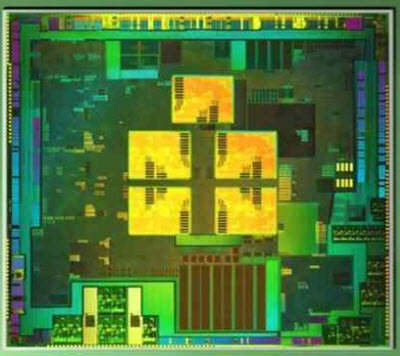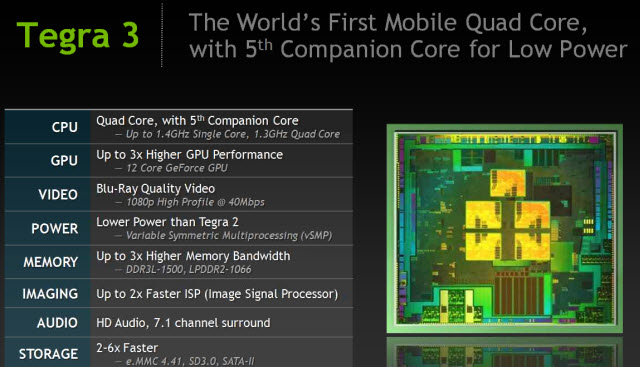 Chip-maker Nvidia is formally launching its Tegra 3 quad-core mobile processor for smartphones and tablets. The company says the processor will make mobile devices much more visually stunning and power-efficient.
Chip-maker Nvidia is formally launching its Tegra 3 quad-core mobile processor for smartphones and tablets. The company says the processor will make mobile devices much more visually stunning and power-efficient.
The chip is the new flagship for Nvidia’s drive to diversify beyond PC graphics into mobile devices. And in a new announcement, one of the major new customers for the chip is Asus, which will use Tegra 3 in its upcoming Android-based Eee Pad Transformer Prime tablet.
Formerly known under the code name Project Kal-El, the Tegra 3 chip has a lot of horsepower for both computing and graphics. It has four cores, or computing brains, plus an additional “companion core” that is used to handle small tasks and dramatically lower the power consumption of the entire chip.
 Santa Clara, Calif.-based Nvidia, the world’s biggest independent stand-alone graphics chip maker, kept the latter core secret until recently, as it considers it a competitive advantage over other chip designs. Each ARM-based central processing unit (CPU) core on the Tegra 3 can automatically turn on or turn off as needed. If the cores aren’t needed, turning them off saves a great deal of power, allowing a mobile device with the chip to operate with a longer battery life.
Santa Clara, Calif.-based Nvidia, the world’s biggest independent stand-alone graphics chip maker, kept the latter core secret until recently, as it considers it a competitive advantage over other chip designs. Each ARM-based central processing unit (CPU) core on the Tegra 3 can automatically turn on or turn off as needed. If the cores aren’t needed, turning them off saves a great deal of power, allowing a mobile device with the chip to operate with a longer battery life.
Matt Wuebbling, product marketing manager for Tegra at Nvidia, said in a press call that the chip can operate with a single companion core at low-power levels and run a high-definition video for up to 12 hours on a single battery charge. Meanwhile, the four cores provide performance that is about three times better than last year’s Tegra 2 on graphics performance with 61 percent lower power consumption.
That is essentially bringing PC-like graphics performance to tablets and smartphones, Wuebbling said. Because the quad-core chip dynamically turns on and off its cores, it consumes less power than many dual-core chips. The companion core runs at 500 megahertz and is powerful enough to handle music and video playback, loading light graphics web sites, and updating background data.
 The four cores start running when a device starts performing tasks such as heavy-graphics web browsing, multitasking, and gaming.
The four cores start running when a device starts performing tasks such as heavy-graphics web browsing, multitasking, and gaming.
“Nvidia’s fifth core is ingenious,” said Nathan Brookwood, analyst at Insight 64. He said that the technology extends battery life for next-generation mobile devices and then ratchets up the performance in a just-in-time basis.
The quad-core CPUs are complemented with a new 12-core Nvidia GeForce graphics processing unit (GPU), which can deliver PC-like gaming effects such as dynamic lighting, physics effects, and stereoscopic 3D viewing.
 Graphics is Nvidia’s specialty, but it will face a lot of competition from the likes of Qualcomm as well as ARM itself, which makes its own graphics cores that are licensed by other chip makers. The Tegra 3 supports game controllers and allows consumers to play games on the tablet, smartphone, or connect to a big screen to fully display a game in high resolution. Nvidia’s 3D Vision stereoscopic 3D technology works with the Tegra 3 chip as well. It accelerates Flash Player 11.1, HTML5, and WebGL browsing to enable faster web viewing. It is also quite fast at photo viewing and editing, as well as converting video from one format to another.
Graphics is Nvidia’s specialty, but it will face a lot of competition from the likes of Qualcomm as well as ARM itself, which makes its own graphics cores that are licensed by other chip makers. The Tegra 3 supports game controllers and allows consumers to play games on the tablet, smartphone, or connect to a big screen to fully display a game in high resolution. Nvidia’s 3D Vision stereoscopic 3D technology works with the Tegra 3 chip as well. It accelerates Flash Player 11.1, HTML5, and WebGL browsing to enable faster web viewing. It is also quite fast at photo viewing and editing, as well as converting video from one format to another.
Nvidia has highlighted a number of demanding games that will run fast on Tegra 3, including Nvidia Tegra Zone featured apps such as Shadowgun THD, Riptide GP, Sprinkle, Big Top THD,  Bladeslinger (pictured right), DaVinci THD and Chidori. By the end of 2011, about 40 games will be available to run on Tegra 3 and 15 more games are under development for the Android Market.
Bladeslinger (pictured right), DaVinci THD and Chidori. By the end of 2011, about 40 games will be available to run on Tegra 3 and 15 more games are under development for the Android Market.
Marek Rabas, chief executive of Madfinger Games and maker of Shadowgun THD, said that the game will take advantage of graphics features such as rag-doll physics, high-quality water simulation, particle effects and more.
The four CPU cores are based on the ARM Cortex A9 core. The memory bandwidth is three times higher than the Tegra 2. The image signal processor runs twice as fast as the Tegra 2. Wuebbling said the Tegra 3 is in production now but declined to say when other customers would make announcements of new devices using the chip.
Sam Williams, general manager at Luma Arcade, said, “This is a recipe for all-day game play,” regarding the Tegra 3’s performance and power consumption. Nvidia has statements of support from dozens of other game makers.
After Tegra 3 launches, Nvidia will launch a new chip every year in the Tegra family. The chip, code-named Wayne, will launch in 2012. Logan will launch in 2013, and Stark will launch in 2014. While Tegra 3 has about five times the performance of Tegra 2, Wayne will have about ten times the performance of Tegra 2.
Nvidia says the Tegra 3 is two times faster at video transcoding than the Apple A5 chip used in the iPad 2, and it is also two times faster at stitching photos together than the A5.

VentureBeat's mission is to be a digital town square for technical decision-makers to gain knowledge about transformative enterprise technology and transact. Learn More
